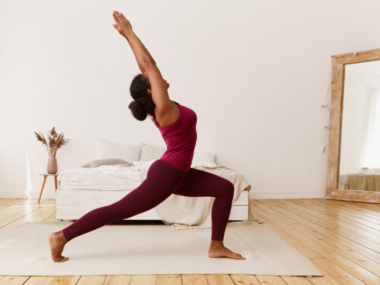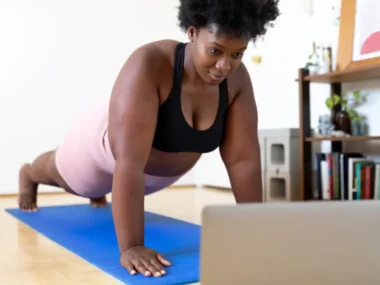We frequently focus on motivation when it comes to exercising—both finding and maintaining drive. While it may appear that motivation is the most important factor in making exercise a regular habit, this isn’t always the case.
Any exerciser will likely answer “no” when asked if they are truly motivated to get up at 5 a.m in the morning to go to the gym. Is there really anyone who wants to work out first thing in the morning? No chance. The secret is to make exercise a habit.
What Is a Habit?
A behavioural pattern we engage in repeatedly and persistently is called a habit. There are probably hundreds of them, ranging from the way you fold your laundry to how you get dressed in the morning.
Habits frequently occur naturally, and the more we engage in them, the more deeply ingrained they become in our minds. Our routines and habits are controlled by a particular region of the brain called the basal ganglia. It’s what takes over when you’re performing an action without giving it much thought, such as loading the dishwasher or driving a vehicle.
RELATED: 8 Scientific Health Benefits of Turmeric
It is unnecessary to consider how to pick up a dish, place it in the dishwasher, and how to open the dishwasher. Furthermore, you don’t need to think about the numerous actions required to drive a car, such as getting the keys, opening the door, sitting down, fastening your seatbelt, etc.
Because of the automation, you can complete these tasks without having to think about them, freeing up mental resources for more significant tasks. But in order to make these actions automatic, you must repeatedly engage in them. Only then will you stop having to think about them.
How to Form a Habit that Sticks
The author of “The Power of Habit,” Charles Duhigg, contends that developing habits involves three key components. A cue, a behaviour, and a reward are required.
A cue may be something like leaving your gym attire next to the bed. As soon as you stand up, you notice the clothes, which serves as a cue for you to put them on in order to get ready for your workout. Exercise completion is the behaviour, and feeling good about yourself or taking a long, hot shower with your preferred items could be the reward.
In addition, Duhigg claims that you need to have a desire for the reward and confidence in your ability to carry out the exercise you’ve scheduled in order for the habit to take hold, particularly when it comes to exercise.
How to Establish a New Exercise Habit
There are many tiny behaviors that go into working out. It can seem like a lot when added together. The payoff could seem insignificant in relation to the amount of work you’ll have to do until you realize how challenging the procedure is. This is particularly true if your objective is to lose weight, which is typically a very sluggish process.
RELATED: 15 Tips for Losing Weight That Really Work
Even though we desire to be healthy and/or lose weight, this is just one reason why many of us struggle to maintain an exercise habit. What is your process then?
Plan Your Cues
Consider a cue as something that prompts your mind to say, “This is the right time to exercise.” This could be:
- Scheduling your workouts on your calendar. Pick times and days you know you can squeeze in exercise, even if it’s just 5 minutes. Plan to walk after lunch every day or take a walk after dinner.
- Putting on your workout clothes as soon as you wake up or right when you get home from work.
- Doing some other healthy behavior before your workout. Drink a glass of water, take some deep breaths, go for a quick walk, or do some stretches. Sometimes, taking one simple action can put you in the mindset of exercise.
- Write down your workout plan and put it next to the bed so it’s the first thing you see when you wake up.
While you’re doing this, take a look at any other cues you may have been following that cause you to feel compelled to skip your workout. Perhaps you choose to hit the snooze button rather than getting out of bed and exercising, or perhaps you choose to relax on the couch after work rather than going to the gym.
You can develop a new habit of working out in place of your current one of lazing on the couch.
Make a Workout Plan
The behaviour component is the most important aspect and frequently the one where we err the most. We frequently overextend ourselves during our workouts because we are so eager to lose weight and make up for lost time.
You can try to resume an exercise regimen you could manage or design your routines based on what you believe is appropriate. Your choice of how frequently to exercise, what kind of exercise to do, and how much weight to lift can be influenced by this.
The issue with this strategy is that you will probably become extremely sore, possibly sustain an injury, and wonder why someone would intentionally harm themselves. However, the only approach to truly develop the habit of exercising is to make your routines so simple and attainable that skipping them seems ridiculous.
The self-efficacy—also referred to as self-belief—belief that you can effectively develop an exercise habit is one of the essential components for making this happen. Create a routine that you are confident in, even if it deviates significantly from the recommended exercises.
RELATED: Vitamin D Supplement May Reduce the Risk of Heart Attack
Sample Workout Options
Forget working out for an hour or doing hardcore cardio training and think more about workouts you can do no matter what. Consider routines you can complete even when you’re tired, stressed, or low on motivation. Here are a few options to consider:
- 5-minute walk: Set a goal for just five minutes every day. Chances are you’ll keep going a little longer than that.
- Quick and easy core workout: This workout includes seven simple exercises that focus on building a strong core.
- Beginner ball workout: This easy-to-follow workout has simple, feel-good exercises that are perfect for introducing your body to exercise. It’s also good for balance and stability.
- Body weight exercises: Another way to keep things simple is to choose a few exercises that don’t require any equipment. Try a squat, pushup, lunge, crunches, and back extensions.
Do each exercise for a single set ranging from 10 to 16 reps. Do continue to increase your set count as you get stronger.
Plan Your Rewards
Exercise has some inherent benefits. Even just finishing a workout can feel nice, and if you stick with it over time, you’ll start to crave that sensation. You can even design your own incentives, like:
- A guilt-free hour of TV
- A glass of wine with dinner
- Paying yourself (give yourself $5 for every workout you complete, for example, and plan what you’ll get with that money at the end of the month)
- Taking a hot bath
- Reading a new book
- Downloading new songs to your workout playlist
- Downloading a new app (Charity Miles allows you to earn money for charity while you walk, run, bike, or do any kind of activity)
The idea is to give yourself a treat every time you exercise so that you develop a craving for it.
RELATED: After my workout, should I eat carbs?
Additional Advice to Help You Stick to Your Exercise Habit
You can also do a few additional things to strengthen your brand-new exercise habit. These consist of:
- Do your workouts at the same time every day, if at all possible.
- Create a ritual around your workout. Put on your workout clothes first thing in the morning or, if you’re leaving from the office, put your gym bag in the seat next to you so seeing it will remind you of your goals.
- Log your workouts. Keep a calendar and put an ‘X’ on every day you exercise.
- Do something you like. You don’t have to love exercise, but it should be an activity you enjoy as well as being one you know you can do without too much pain or discomfort.
- Focus on the habit first, then the results. Too often, we’re so focused on losing weight that we end up quitting when it doesn’t happen soon enough. Instead, focus on doing the workouts versus paying so much attention to the results.
Final Thoughts
Making it as simple as possible to complete your workouts is the key to developing an exercise habit. Pick accessible activities that you enjoy, keep your workouts straightforward, and concentrate on simply turning up.
Starting is frequently the most difficult step, so the simpler you can make it, the more successful you’ll be. You’ll quickly develop a habit that comes effortlessly if you coordinate your cue, behaviour, and reward.





